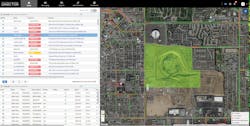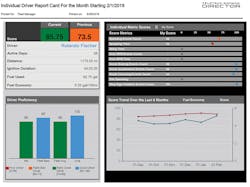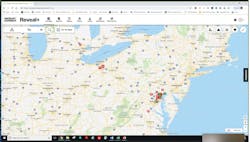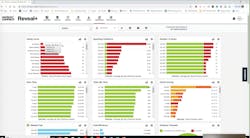So the good news is your plumbing business is growing. You’ve brought in some new guys. You’ve bought or leased some new trucks. Your area of operation is expanding.
The bad news is you’ve got growing pains. It’s just taking too long to get yourself and your guys from job to job quickly, safely, and efficiently (meaning the guy with the right training along with the right tools and parts). It’s making some of your customers upset, with calls along the lines of: “Hey, we never had wait times like this when you were a one-man/two-man operation – what gives?” There are even some jobs you miss out on, not because you don’t have the manpower, but because you can’t use it effectively.
So you make the back-office investment. That’s probably a dedicated customer service representative or two. One of the CSRs either handles dispatch or you go the extra mile and hire a dispatcher as well. And, obviously, those back-office people are going to need a software package to help them manage the team.
You do some research, and lo and behold, the most popular systems ALL seem to have two things in common. First, they all work on a subscription model, where you’re charged a monthly fee. Second, they all seem to involve a GPS-based device that gets installed in the vehicle.
And you think to yourself, I don’t need all that. All my guys have smart phones with Google Maps to let them know where they are and where they should go. I don’t need a monthly service. What possible benefits could there be to my business that would outweigh the extra cost?
The answer? Quite a lot, actually. Telematics, the science of transportation information, can tell you more about the location, condition, and use of your vehicle assets than you ever thought possible, delivering efficiency, safety, and the kind of next-level customer experience that, combined, can produce a fantastic return on investment.
CONTRACTOR recently spoke with three companies on the vanguard of applied telematics: Teletrac Navman, GPS Insight, and Verizon Connect. All provide custom solutions to their customers in the service industry.
What do you know – how do you know it?
The obvious benefit of an installed GPS device is that it is tied to the vehicle, not to the operator.
“Once the driver gets out of the vehicle,” Sid Nair, Director of Transport Practice at Teletrac Navman says, “you have zero visibility of where your vehicle asset is.”
Teletrac Navman has been in business almost 30 years. Currently, the Southern California-based company helps track 600,000 assets globally in the transportation, construction and service industries.
The company has actually provided both a GPS-based and a smart phone-based application. Many of their customers started out with the smart-phone based solution, but soon came around to the value of a dedicated, connected, in-vehicle asset tracker. Why? Because you know for sure; you’re not guessing, and you’re not depending on an employee who may switch his or her phone off at almost any time for any reason.
“I would like to live in a world where I trust everybody and I know my drivers and want to believe all they say,” Nair says, “but realistically, there are going to be situations where you have a 10-20 truck company, where you’re not a family owned-operated business, where you’re actually employing people from outside. (So) you have to have some level of accountability.”
That certainty is the bedrock all the different solutions these companies offer and build upon. But it is the wealth of information being collected – and transmitted in real-time – by the dedicated, in-vehicle device that lets these systems deliver such an amazingly detailed picture of the vehicle in operation.
“Location is the obvious one,” Nair says. “We can do acceleration, breaking and cornering – which are three things we know because we have a gyroscope on board. So is harsh driving behavior. We have stop sign violations… we know if you roll through a stop sign or jump a stop sign because we can match that to our stop sign database.”
Systems can provide information on a diagnostic level. Through a vehicle’s OBD (On Board Diagnostics) II port – standard on most vehicles since 1999 – the device has access to almost all the information coming out of the vehicle’s computer. That means idle times, fuel burn – even when a trailer hitch is or isn’t engaged.
Safety on the road
For end-users, one of the most important questions all that data can answer is: Who are my safe drivers? Unsafe driving increases insurance costs. Drivers who get in accidents end up late to customer appointments. And those trucks are your rolling billboards – seeing one in a ditch or wrapped around a tree can make a terrible impression on the minds of passing motorists.
So, all the solutions discussed here offer driver safety reports. Verizon Connect makes a case in point with its customer, Bill Howe Plumbing, Heating & Air, Restoration & Flood Services, based in San Diego, CA. The company’s Risk Manager, Rhett Wheeler, now receives immediate alerts – texted to him automatically – whenever his drivers break a series of set conditions (hard breaking, hard turning, speeding, etc.). Verizon Connect also provides a series of weekly reports that ranks your drivers from best to worst. Managers like Wheeler then can coach team members who need it, and reward those members who are setting a good example.
“The safety reports initially were very shocking,” Wheeler says. The average safety score was a 77, and some were below 30. Through driver coaching, the average improved to a 97. The year before implementing the system, the company had 16 accidents totaling nearly one million dollars in damages. After implementation, accidents dropped to just two.
Wowing the customer
But dispatch, getting the service technician from job site to job site, is still the main value of telematic systems to most service contractors.
Now those dispatch functions are able to integrate with almost every facet of running a contracting service: scheduling, invoicing, job history, customer history, parts and prices, even capturing photos, documents and signatures to provide proof of service.
According to Jenny Shiner, Marketing Communications Manager for Chicago-based GPS Insight, “In today’s highly competitive service industries, contractors are focusing on the importance of customer experience to help drive revenue. Organizations have changed their customer experience priorities in recent years and are realizing how crucial it is to customer retention, as well as winning new business.”
Over the past 13 years, GPS Insight has worked with service businesses to help solve customer challenges. The company currently tracks more than 150,000 assets.
More efficient dispatch means more than just seeing more customers in the course of a work day. It means being able to communicate to those customers more accurate time windows of when service providers will be on-site.
And keep in mind, all these systems are meant to be customized, not just to your type of business, but to your company’s own particular workflow.
“What we’ve seen is that almost every different [plumbing] company has its own quirky way of running the business,” Sid Nair says. “So we spend the first hour trying to customize a solution to meet your needs.”
And because these are subscription services, that means a high level of customer support, particularly when it comes to training your back-office staff. Nair – who came to Navman from a background in customer support – says his company takes a multi-pronged approach, offering in-product training (help menus and pop-ups), knowledge-based training, video training, on-site training, whatever the customer needs.
What else? What’s new?
“This is a developmental time for the telematics industry with many exciting technologies on the horizon,” adds Shiner. “For GPS Insight, we believe that camera systems, 5G cellular technology, and mesh networks will be a significant part of the next generation of fleet management.”
In a wireless mesh network, the network connection is spread out among dozens or even hundreds of wireless mesh nodes that connect directly, dynamically and non-hierarchically to as many other nodes as possible, to cooperate with one another more efficiently.
Nair also believes that in-vehicle cameras will be a big part of the future, particularly (at first) for larger companies. Having some kind of camera data will help avoid being fraudulently charged for something their drivers didn’t do.
But Nair is waiting for the day – still two-to-five years out, he thinks – when the software is advanced to the point it can put all the pieces together.
“I’ve gotten a couple larger transportation companies who have come to me with the question: should I be leasing or buying?” Nair says. “How do I look at my lease cost versus my utilization time versus my maintenance costs? If I had to buy, what would my interest rate be? That level of effectiveness, putting in matching data, makes that next level of data intelligence.”
When that day arrives, you can be sure all three companies will be offering that level of intelligence to their customers.
About the Author
Steve Spaulding
Editor-in-Chief - CONTRACTOR
Steve Spaulding is Editor-in-Chief for CONTRACTOR Magazine. He has been with the magazine since 1996, and has contributed to Radiant Living, NATE Magazine, and other Endeavor Media properties.







